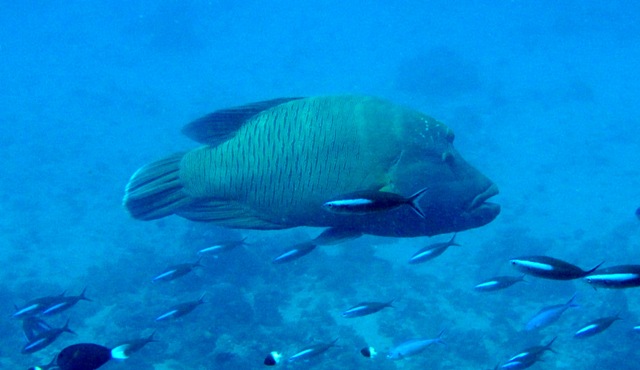Dec 24 2015
Permanent marine protected areas and wilderness—places where fish can grow old—are critical to the effective conservation of marine ecosystems according to a new study conducted by the Wildlife Conservation Society, James Cook University, and Lancaster University.
 A newly published study in the journal Proceedings of the Royal Society B has found that the ages and growth rates of long-lived fish species such as the humphead wrasse are important factors in measuring the recovery of Indian Ocean coral reef ecosystems, some of which may need more than 100 years of protection to rebound from overfishing. (Tim McClanahan/WCS)
A newly published study in the journal Proceedings of the Royal Society B has found that the ages and growth rates of long-lived fish species such as the humphead wrasse are important factors in measuring the recovery of Indian Ocean coral reef ecosystems, some of which may need more than 100 years of protection to rebound from overfishing. (Tim McClanahan/WCS)
Unlike previous research focused primarily on the weight or biomass of fish as a measure of reef recovery, this study evaluated the life histories of fish communities. In doing so, the researchers found much slower change—well beyond the 20 years that it took for biomass to recover—and some factors like growth rate were expected to change for more than 100 years. The findings underscore the importance of permanent marine protected areas and wilderness in the effective protection of marine fishes.
The study titled “Marine reserve recovery rates towards a baseline are slower for reef fish community life histories than biomass” appears in the online version of Proceedings of the Royal Society B. The authors are: Tim R. McClanahan of WCS; and N.A.J. Graham of James Cook University and Lancaster University.
To access the study, click here: http://rspb.royalsocietypublishing.org/content/282/1821/20151938
“Fish biomass has been the common way to evaluate fish communities, but what our research shows is that it does not tell the entire story,” said Dr. McClanahan, Senior Conservationist for WCS and co-author of the study. “Analyses based primarily on fish biomass produces an incomplete and somewhat misleading scenario for fast recovery from overfishing. What we found was a slow and continuous reorganization of the fish community well past the stabilization of biomass. A full evaluation of marine reserves needs to look at the species and their life histories and, when we do that, we see the importance of protecting ocean wilderness and making permanent and large reserves.”
The study combined fish censuses from more than 300 coral reefs to examine how they changed in response to fishing methods and the number of years they had been closed to fishing. They also compared the reefs in marine reserves with the remote Chagos Archipelago, a relatively pristine marine ecosystem off limits to exploitation due to its status as a large military base in the Indian Ocean. The authors built on previous work that had largely concluded that recovery times for reefs can be reliably based on the biomass of the fish. When looking at all factors, the authors found that biomass was one of the few measures that leveled off after a limited number of years, whereas metrics including body sizes, age, and feeding habits continued to change for 40 years and growth rates were projected to decline for over 100 years.
“The slow growing species in marine reserves could require a century to fully recover, indicated the importance of permanent and large reserves,” added McClanahan.
The study also tested the effects of the size of the protected area, the length of closure time, and how successful the protected area was at eliminating fishing. McClanahan and Graham hypothesized and found that estimated recovery rates would vary with the success of the closure regulations. Closures with weak compliance recovered to only half the biomass levels of the high compliance closures and also produced small and younger fish communities, an indication of incomplete recovery. Including sharks in the analysis had some effects on the final body sizes but overall the findings would be nearly the same if sharks were excluded. Nevertheless, slow growing sharks, parrotfish, triggerfish and groupers are among the species with poor recovery in small, young, and low compliance closures.
“If you want to protect the longer-lived, slower growing species, you need old, large, and high compliance marine reserves” said Nick Graham, a co-author on the study. “The effective protection of the full suite of fish species and life history characteristics will depend on the establishment of large reserves with strict enforcement.”
“With governments around the world committed to protect 10% of the oceans by 2020, this study provides important insight into the long term horizon needed to fully realize the benefits of today's ocean conservation efforts,” said Dr. Caleb McClennen, Executive Director of WCS’s Marine Conservation Program. “The importance of designing scientifically defensible large marine reserves only solves the first pieces of the equation - long term capacity to enforce and ensure compliance will take the long term focus of the ocean conservation community.”
This research was supported by the John D. and Catherine T. MacArthur Foundation and the Western Indian Ocean Marine Science Association (WIOMSA).
WCS (Wildlife Conservation Society)
MISSION: WCS saves wildlife and wild places worldwide through science, conservation action, education, and inspiring people to value nature. To achieve our mission, WCS, based at the Bronx Zoo, harnesses the power of its Global Conservation Program in nearly 60 nations and in all the world’s oceans and its five wildlife parks in New York City, visited by 4 million people annually. WCS combines its expertise in the field, zoos, and aquarium to achieve its conservation mission. Visit: newsroom.wcs.org Follow: @WCSNewsroom. For more information: 347-840-1242 FREE.
The MacArthur Foundation supports creative people and effective institutions committed to building a more just, verdant, and peaceful world. In addition to selecting the MacArthur Fellows, the Foundation works to defend human rights, advance global conservation and security, make cities better places, and understand how technology is affecting children and society. More information is at www.macfound.org.